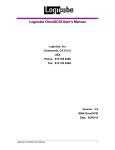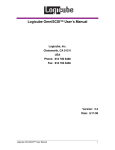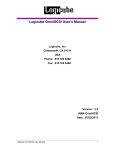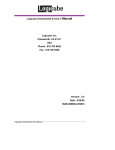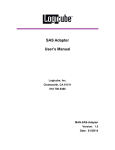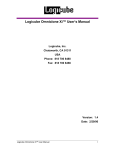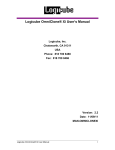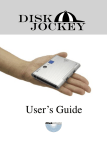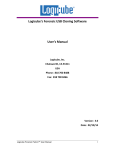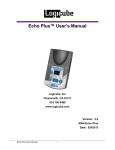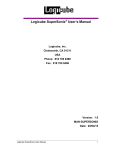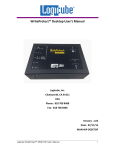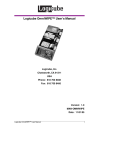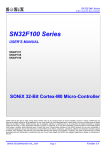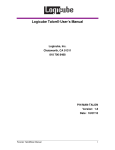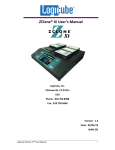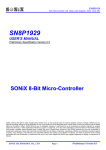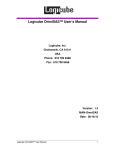Download Logicube Sonix™ User`s Manual - AKL Technology Engineering
Transcript
Logicube Sonix™ User’s Manual AKL Technology E & S 23 Woodlands Industrial Park E1, #04-05 Admiralty Park Singapore 757741 Phone: (65) 6891 6266 Fax: (65) 6891 6366 E-mail: [email protected] Version: 1.0 Date: 6/29/04 Logicube Sonix™ User Manual I TABLE OF CONTENTS Table of Contents LOGICUBE SONIX™ USER’S MANUAL.....................................................I TABLE OF CONTENTS ...............................................................................II 1. INTRODUCTION TO THE LOGICUBE SONIX™ ...................................1 Introduction .......................................................................................... 1 Features .......................................................................................... 2 Using this guide............................................................................... 3 System description .......................................................................... 3 2. GETTING STARTED (FAST START)......................................................7 Applying power to the Logicube Sonix™ ......................................... 7 Connecting a Parallel (IDE) Drive ................................................... 7 Connecting a Serial ATA (SATA) Drive .......................................... 9 Connecting other types of drives .................................................... 9 The user interface.............................................................................. 11 “Shortcut” buttons (available at all times)...................................... 11 “Soft” Buttons ................................................................................ 11 Scroll buttons................................................................................. 11 Alphanumeric Keypad ................................................................... 12 Indicator Lights .............................................................................. 12 3. MENU TREE ...........................................................................................14 4. CLONING MODES AND SETTINGS....................................................16 Main Menu Screen ............................................................................. 16 About Screen................................................................................. 16 Drive Info ....................................................................................... 16 Screen Saver................................................................................. 16 Cloning................................................................................................ 17 Clever Clone™ Mode.................................................................... 17 Clever Clone™ Step-by-Step........................................................ 17 Selective Partitions™ Mode .......................................................... 18 Copy Methods ............................................................................... 18 II Logicube Sonix™ User’s Manual TABLE OF CONTENTS Selective Partitions™ Step-by-Step.............................................. 19 100% Clone™ (Mirror) Mode ........................................................ 20 Mirror Clone™ Step-by-Step......................................................... 21 Master Manager™ Mode .............................................................. 21 Master Manager™ Step-by-Step .................................................. 22 DELL Optiplex™ Computers and Master Manager™................... 23 Optional Preference Settings ........................................................... 24 Verify ............................................................................................. 24 Verify Settings ............................................................................... 24 Speed ............................................................................................ 25 Direction ........................................................................................ 25 CHS Translation ............................................................................ 26 CHS Translation Settings.............................................................. 26 Security Identification Number (SID) Issues ................................. 27 Enable Option................................................................................ 27 Password Protection ......................................................................... 28 Introduction.................................................................................... 28 Setting a Password ....................................................................... 28 Changing or Removing the Password .......................................... 28 5. OMNIDIAGNOSTICS™.........................................................................29 Introduction ........................................................................................ 29 Enabling OmniDiagnostics™ ........................................................ 29 OmniDiagnostics™ Features ........................................................... 30 Drive Health................................................................................... 30 Drive Health Step-by-Step ............................................................ 30 On Error......................................................................................... 30 On Error Step-by-Step .................................................................. 31 Scan Target Mode......................................................................... 31 Scan Target Mode Step-by-Step .................................................. 32 Repair Target Mode ...................................................................... 32 Repair Target Mode Step-by-Step ................................................ 33 WipeClean™ Target Mode............................................................ 33 WipeClean™ Settings ................................................................... 34 Wipeclean™ Target Step-by-Step ................................................ 34 6. USING THE CLONECARD PRO™ .......................................................35 Introduction ........................................................................................ 35 Before using .................................................................................. 36 Creating a MS-DOS floppy boot disk ............................................ 36 Cloning with the CloneCard Pro™ ................................................ 37 Things to note................................................................................ 37 Improving Speed of Transfer......................................................... 38 Supported chip-sets .......................................................................... 39 7. USING THE USB PORT.........................................................................40 Logicube Sonix™ User’s Manual III TABLE OF CONTENTS Introduction ........................................................................................ 40 Minimum requirements.................................................................. 40 Enabling the USB Cloning Option................................................. 41 How to use under Windows (for Master Drive Management)....... 42 Removing USB devices ................................................................ 43 Cloning through the USB port ....................................................... 43 How to set up and use the USB Cloning software:....................... 43 8. COMPACT FLASH (CF) CARD.............................................................45 Introduction ........................................................................................ 45 Inserting and Removing the Compact Flash................................. 45 Connecting the CF Drive to Windows via USB............................... 46 Connecting Through USB Mode ................................................... 46 Connecting Through the Software Setup Menu............................ 47 Removing USB devices ................................................................ 48 9. SOFTWARE LOADING INSTRUCTIONS .............................................49 Logicube Sonix ™ Software Updating Procedures ....................... 49 Loading Software Using the Compact Flash ................................ 49 Loading Software Through the Parallel Port................................. 50 Host PC preparation...................................................................... 50 Logicube Sonix™ Software Update .............................................. 51 10. REFERENCE ........................................................................................52 Glossary.............................................................................................. 52 11. FREQUENTLY ASKED QUESTIONS AND ANSWERS ....................58 FAQ’s .................................................................................................. 58 Troubleshooting Guide ..................................................................... 61 12. INDEX...................................................................................................64 IV Logicube Sonix™ User’s Manual 1. Introduction to the Logicube Sonix™ Introduction Thank you for purchasing the Logicube Sonix™ Hard Drive Duplication device. With proper use, this system will provide you with accurate HDD cloning for years to come. The Logicube Sonix™ duplicates or “clones” the contents of one hard drive onto another; a source drive, typically referred to as the Master1 and a destination drive known as the Target. It is capable of copying data from the Master drive to the Target drive at speeds of more than 3.0 GB/ min. The unit also has the capability to clone data to/from a hard drive installed inside a PC through the USB port2. The unit can also access drives through the PCMCIA slot with the optional Logicube Clone Card Pro™ PCMCIA Adapter. 1 2 The term Master as used does not refer to the master jumper setting on the hard drive. This feature is available if the USB Cloning Option is installed. Logicube Sonix ™ User’s Manual 1 INTRODUCTION The Logicube Sonix™ has an intuitive user interface and powerful features that make hard drive cloning fast and easy. It also has an easy-toread “OLED” display. Logicube’s exclusive Clever Clone™ technology automatically supports all DOS, Windows 95/ 98/2000/ME/XP and Windows NT partitions while the advanced 100% Clone™ mode can perform sector-by-sector copying for all partition types including Mac, Linux, Unix, Sun, and OS2. The optional OmniDiagnostics™ software adds additional features for finding and repairing hard drive data problems, recovering weak or bad data sectors, and securely erasing personal and confidential information. Features • Clones any IDE, EIDE or Serial ATA Drive. • Data transfer rates in excess of 3.0 GB/min. • Master and Target drives can be of different size, make and model. • Master drive can contain up to 24 partitions. • Automatically scales FAT16/32, NTFS 4.0/5.0/6.0, and Windows 2000/NT/ME/XP partitions. • USB port connectivity (optional) • PCMCIA connectivity (optional) • Optional diagnostics software for drive scanning and repairing, data recovery, and Department of Defense (DoD) specification data wiping. • Removable Compact Flash (CF) Drive. 2 Logicube Sonix ™ User’s Manual INTRODUCTION Using this guide This user guide is made up of 10 sections: • Introduction • Getting Started (Fast Start) • Menu Tree • Cloning Modes and Settings • Omnidiagnostics™ • Using the Clone Card Pro™ • Using the USB Port • Compact Flash (CF) Drive • Software Loading Instructions • Reference • Frequently Asked Questions Please read Modules 1. Introduction, and Module 2. Getting Started before attempting a drive cloning session. It is recommended that you practice with a scratch drive to fully appreciate all of the features. System description The complete Logicube Sonix™ system includes the following: • Logicube Sonix™. NOTE: The Logicube Sonix™ system does not come with a hard drive. You may insert the drive of your choice. • An external 12VDC – 5.5A power supply. • Two 80-conductor flat ribbon cables (5” and 9”) for connecting the Master and Target drives to the Logicube Sonix™. • One extra 5” 80-conductor flat ribbon test cable in a sealed bag. NOTE: Please do not remove the test cable from the sealed bag unless requested to do so by a Logicube Technical Support representative. • Two PC-style accessory power cables (one shorter, one longer) for connecting the Master and Target drives to the Solitaire Turbo. • Two Serial ATA cables, one short and one long, for attaching Serial ATA drives to your Logicube Sonix™. Logicube Sonix™ User’s Manual 3 INTRODUCTION • A floppy disk containing: A. A backup copy of the software that is already pre-installed on the Logicube Sonix™. B. Software update utilities as well as all files found on the Compact Flash (CF) drive. • A second Floppy Disk containing Windows 98/ME drivers for connecting through the USB port. • A third floppy boot disk that contains the USB Cloning software for copying drives through the parallel port (optional). • A screwdriver and Mag-Lite® flashlight for opening and looking inside a PC. • A vacuum-formed carrying case. NOTE: It is recommended that you always use the carrying case to store and carry the Logicube Sonix™. • This manual. Figure 1. Logicube Sonix™ 4 Logicube Sonix ™ User’s Manual INTRODUCTION Caution: Avoid dropping the Logicube Sonix™ or subjecting it to sharp jolts. When in use, place it on a flat surface. Caution: Keep the unit dry. If you need to clean your Logicube Sonix™, use a lightly damp, lint free cloth. Avoid using soap or other cleaning agents particularly those containing bleach, ammonia, alcohol or other harsh chemicals. Caution: Do not attempt to service the Logicube Sonix™! Doing so may void the warranty. If your unit requires service, please contact Logicube Technical Support for assistance. Logicube Sonix™ User’s Manual 5 2. Getting Started (Fast Start) Applying power to the Logicube Sonix™ The Logicube Sonix™ is able to detect whether an IDE (parallel) or Serial ATA (SATA) drive is attached to the Master or Target position. The unit is capable of cloning to/from a SATA drive to an IDE drive and vice versa (as well as IDE to IDE and SATA to SATA). NOTE: Never attach both an IDE and SATA drive to the Master or Target position. The unit can only handle one drive on each position. Before applying power perform the steps listed below. Connecting a Parallel (IDE) Drive 1. Open the Logicube Sonix™ by pressing on the two latches at the base of the unit and lifting the top. You will notice three connections: One for a flat cable (the drive data cable) and another for a small drive power cable. Underneath is the third connector for the Serial ATA cable. Note: See Figure 2, Connecting a Master drive to the Logicube Sonix™ through 5” Data/Power cables. 2. Connect a Master hard drive and close the Logicube Sonix™. 3. Plug in the set of 9” cables, to the connections found on the back of the Logicube Sonix™. Note: See Figure 3, Connecting a Target drive to the Logicube Sonix™ through 9” data/power cables. 4. Connect the Target drive to these cables. Note: The internal drive is always referred to as the Master drive and the outside drive is always referred to as the Target drive. 5. Connect the external power supply to the Logicube Sonix™ and power-up the unit. In 2 – 3 seconds, the main “Splash” screen appears. Logicube Sonix ™ User’s Manual 7 GETTING STARTED Figure 2. Connecting an IDE (parallel) Master Drive Figure 3. Connecting an IDE (parallel) Target Drive 8 Logicube Sonix ™ User’s Manual GETTING STARTED Connecting a Serial ATA (SATA) Drive 1. Open the Logicube Sonix™ by pressing on the two latches at the base of the unit and lifting the top. You will notice three connections: One for a flat cable (the drive data cable) and another for a small drive power cable. Underneath is the third connector for the Serial ATA cable. Note: See Figure 4, Connecting a Master drive to the Logicube Sonix™ through a 5” SATA cable. 2. Connect a Master hard drive and close the Logicube Sonix™. Make sure that Pin 1 is properly aligned. 3. Plug in the long SATA cable to the connections found on the back of the Logicube Sonix™. Note: See Figure 5, Connecting a Target drive to the Logicube Sonix™ through a 9” SATA cable. 4. Connect the Target drive to this cable. Note: The internal drive is always referred to as the Master drive and the outside drive is always referred to as the Target drive. 5. Connect the power supply to the Logicube Sonix™ and power-up the unit. In 2-3 seconds, the main display appears. Connecting other types of drives Logicube sells specialized adapters that allow the following types of drives to be connected to the Logicube Sonix™: • 2.5” Laptop drives (also called Notebook drives). • 1.9” Laptop drives, (e.g. Toshiba iPod™ drives). • Compact Flash (CF) Drives. Other specialized adapters are also available. If you are unsure about the type of drive that you have, please contact Logicube Technical Support for assistance. Note: SCSI drives cannot be connected directly to the Logicube Sonix™. Please refer to Chapter 6, Using the USB Port, for information on cloning these types of drives. Logicube Sonix ™ User’s Manual 9 GETTING STARTED Figure 4. Connecting a Serial ATA (SATA) Master Drive. Figure 5. Connecting a Serial ATA (SATA) Target Drive. 10 Logicube Sonix ™ User’s Manual GETTING STARTED The user interface The user interface (UI) has been designed with the professional in mind. It is fast, responsive, and to the point; which means it requires very few key strokes to achieve a desired action. It also displays fewer “are you sure” messages that may slow down the cloning session. “Shortcut” buttons (available at all times) NOTE: Refer to Figure 3 as you read the information below. • START/STOP Button – Press it twice to begin a cloning operation using the current settings; press the START/STOP button in mid process to abort it. A single key stroke presents a preview screen where you can see the current setting, and decide whether to press it again to begin the capture, or back out to reconfigure. • The “Help” (”?”) button provides context sensitive help and is active at all times. Press it to get specific help on the current screen. If the selection cursor is on the screen, pressing the Help button will retrieve specific help for that item pointed to. Press the help button again to return to the current screen. • The “Set” button is the third “shortcut” button. It brings you to the settings screen where you can change capture modes and other settings of the unit. “Soft” Buttons The two “Soft” buttons are directly under the LCD display. The button functions change depending on the labels displayed above them. Note: Labels are always enclosed by angular brackets (<>). When no labels are displayed, they function as navigational buttons. The right button functions as “Select” or “toggle” and is used to select an option, to move through multiple available options, or to select a sub-menu. The left button is the “Back” button. This button is used to go “up” in the menu system or to cancel out of a given operation. Scroll buttons The two scroll buttons are active when the right side of the screen displays the scroll arrows. This occurs Logicube Sonix ™ User’s Manual 11 GETTING STARTED when the amount of information to display exceeds the screen size. Menus are also scrollable Alphanumeric Keypad The alphanumeric keypad is laid out like the keypad on your PC or typewriter. It is used for labeling drive partitions (in Selective and Master Manager Modes), entering passwords and other functions. NOTE: Drive partition labels must be 11 characters or less. Indicator Lights The POWER indicator light remains on while the Logicube Sonix™ is receiving power. The STATUS indicator is lit during cloning operations and any operation that accesses the Master or Target drive. It will flash as data is transferred from one drive to the other. The ERROR light will come on if a problem is encountered during cloning or any other operation. If this occurs, check the screen for an error message and instructions on what to do next. 12 Logicube Sonix ™ User’s Manual GETTING STARTED Figure 6. Buttons and Interface Logicube Sonix ™ User’s Manual 13 3. Menu Tree This menu tree shows the layout of the menu system for the Logicube Sonix™. Menu choices are followed by the page number in the manual where they are described. The page numbers are in “<>”. Logicube Sonix ™ User’s Manual 14 CLONING MODES AND SETTINGS Logicube Sonix ™ User’s Manual 15 4. Cloning Modes and Settings Main Menu Screen The main menu screen appears when the Logicube Sonix™ is first powered up. It displays the Title Screen and two menu options: About and Drives. About Screen Select the About Screen by pressing the Back button. It will display the serial number of your unit along with the software and firmware versions that are loaded. In addition, the About screen lists all options currently enabled on the unit and provides contact information for Logicube Technical Support. To return to the main menu, simply press the Back button at any time. Drive Info Select the Drive Info screen by pressing the Select button. Another screen will come up asking you to select either the <Master> or <Target> drive (use the “soft” buttons to make your choice). The unit will then access the drive selected and report back the drive’s model number, capacity, geometry and other information. Scroll down to the end of the drive information list to access the <See more> option. Press the Select button to display all of the partitions located on that drive. To return to the main menu, you may select <Done> by pressing the back button at any time. Screen Saver After 25 seconds of inactivity, the Logicube Sonix™ display will switch to a screen saver. This is designed to extend the life of the OLED display used by the unit. Logicube Sonix ™ User’s Manual 16 CLONING MODES AND SETTINGS Pressing any one of the UI buttons will switch the display back to normal. Cloning The Logicube Sonix™ provides several different modes of operation for cloning virtually any hard drive quickly and effectively. Here we will discuss the most frequently used cloning modes, and provide step-by-step instructions for each. We will also cover each of the other optional preference settings found under the Settings menu, and explain what they do and when to use them. NOTE: At the end of the chapter will be a special discussion on dealing with SID (Security Identification) issues under the Windows NT, Windows 2000 and Windows XP operating systems. NOTE: Each time the Logicube Sonix™ is powered off the cloning mode and preference settings are returned to their factory defaults. Clever Clone™ Mode This is the default operating mode and is recommended for cloning drives with FAT16, FAT32 and NTFS partitions. It clones all partitions on the Master drive to the Target drive and automatically sets the fastest method possible for each partition. Clever Clone™ automatically scales all FAT32 and NTFS partitions to fill the Target drive in its entirety, and makes all the necessary adjustments to ensure a valid and bootable Target drive. It can also scale FAT16 partitions up to 2GB. NOTE: When Clever Clone™ scales down an NTFS partition, it can only scale it to 55% of the original size. Clever Clone™ Step-by-Step 1. From anywhere in the menu system, press the Set button to enter the Settings menu. Logicube Sonix ™ User’s Manual 17 CLONING MODES AND SETTINGS 2. Scroll through the optional preferences – Verify, Direction, CHS Mode, and Speed - and modify them as needed using the Select button to toggle between the different settings for each. NOTE: See the Optional Preference Settings section of this chapter for more information on these preference settings. 3. Locate “Mode” in the Settings menu and press the Select button. The Mode menu screen appears. 4. Locate “Clever” (short for Clever Clone™) in the Mode menu and press the Select button. This will select Clever Clone™ mode and return you to the Settings screen. 5. Press the Start/Stop button twice for cloning to begin. The Status screen will appear. 6. The Logicube Sonix™ will notify you when cloning has been completed. Press the Back button to return to the main menu. Selective Partitions™ Mode Selective Partitions™ is the most elaborate and most flexible cloning mode. It provides the highest level of control over the cloning process, allowing you to individually select one or multiple Master drive partitions. It also allows you to choose a unique copy method for each. NOTE: Not all copy methods are available for all partition types. Copy Methods Clever Clone™ (Default) – Allows the Logicube Sonix™ to determine the best (and usually fastest) way to clone a selected partition. It works with all FAT16, FAT32 and NTFS partitions. Defragment – Using an advanced defragmentation algorithm, this copy method creates a Target partition with contiguous files and no gaps. Works with all FAT16 and FAT32 partitions. NOTE: The Logicube Sonix™ will resort to defragment mode if the given partition is FAT16 and a 18 Logicube Sonix ™ User’s Manual CLONING MODES AND SETTINGS cluster size change is required to create a valid Target partition. Partition Mirror – This setting clones the full contents of the selected partition without any partition scaling. (This setting is similar to 100% Clone mode, which mirrors the entire Master drive.) NOTE: Partition Mirror is available for any partition type, and is the only method available to partitions that are unrecognized by Clever Clone™ mode. Convert FAT16 to FAT32 – Will convert the selected partition from FAT16 to FAT32 format on the fly. This mode is available for FAT16 partitions only. NOTE: Use only when the given partition is to be used with Windows 98/ME or Windows 2000. The 4.00.950 and 4.00.950a versions of Windows 95, Windows NT 3.x and 4.0, and some versions of MS-DOS are incompatible with FAT32 partitions. Selective Partitions™ Step-by-Step 1. From anywhere in the menu system, press the Set button to enter the Settings menu. 2. Scroll through the optional preferences – Verify, Direction, CHS Mode, and Speed - and alter them as needed using the Select button to toggle between the different settings for each. NOTE: See the Optional Preference Settings section of this chapter for more information on these preference settings. 3. Locate “Mode” in the Settings menu and press the Select button. The Mode menu appears. 4. Scroll to the “Selective” menu option and press Select. After a few seconds the Logicube Sonix™ will display a list of all the partitions found on the Master drive. 5. Note that to the right of each partition name, you will see a two-character designator for the partition type: Logicube Sonix ™ User’s Manual • 16 - FAT16 partition • 32 - FAT32 partition • NT - NTFS partition • CQ - Compaq partition 19 CLONING MODES AND SETTINGS • DE - Dell utility partition • PH – Phoenix Recovery partition • ?? - Unknown partition 6. Choose a partition to clone and use the Select button to toggle between the different copying methods available, (Clever Clone™, Defragment, Mirror and Convert to FAT32). Repeat for each partition you wish to clone. NOTE: If no copy method is selected, the partition will not be cloned. 7. With the alphanumeric keypad, you can change the name of a chosen partition by pressing the Set button, entering the new label and then pressing Select. NOTE: A partition label can be a maximum of 10 characters long. No spaces are allowed. 8. Press the Start/Stop button twice to start cloning. The status screen will appear and cloning will begin. 9. The Logicube Sonix™ will notify you when cloning has been completed. Press the Back button to return to the main menu. 100% Clone™ (Mirror) Mode This cloning mode makes a direct, physical copy of the Master drive. It does not adjust any values or perform any translation from drive to drive. It simply copies whatever percentage of the Master drive that is designated. NOTE: This mode is only recommended when Clever Clone™ is unable to copy the drive and then only between drives of similar geometry. 100% (Default) – When 100% Clone is selected, the cloning mode menu will display the percentage of the Master drive that will be copied to the Target. This percentage can be adjusted in increments of 5% using the UP and DOWN arrows, and in increments of 1% using the alphanumeric keypad. The percentage of the Master drive to be mirrored is calculated starting from the first physical sector. 20 Logicube Sonix ™ User’s Manual CLONING MODES AND SETTINGS Mirror Clone™ Step-by-Step 1. From anywhere in the menu system, press the Set button to enter the Settings menu. 2. Scroll through the optional preferences – Verify, Direction, CHS Mode, and Speed - and alter them as needed using the Select button to toggle between the different settings for each. NOTE: See the Optional Preference Settings section of this chapter for more information on these preference settings. 3. Locate “Mode” in the Settings menu and press the Select button. The Mode menu screen appears. 4. Scroll to the “100%” menu option and press Select. This will select Mirror Clone™ mode. 5. A screen appears asking you what percentage of the Master drive to clone. Use the Up/Down scroll arrows to adjust this value in increments of 5%. NOTE: You can also use the alphanumeric keypad to enter any value between 1% and 100% (no decimal places). Press SET at the percentage screen to enter the Keypad Entry screen, enter the percentage desired and press SELECT. 6. Press the Start/Stop button twice for cloning to begin. The Status screen will appear. 7. The Logicube Sonix™ will notify you when cloning has been completed. Press the Back button to return to the main menu. Master Manager™ Mode Master Manager™ mode is useful in the creation of a multi-partition Master drive. Many MIS technicians prefer to store multiple partitions (e.g. one for accounting, one for marketing, etc.) on a single Master drive. When a new PC is to be configured or a drive crash occurs, all the technician needs to do is select that partition and clone it. The Master Manager™ mode is also useful for creating backups of drive partitions containing important data. The Logicube Sonix™ can hold up to 24 partitions on one Master drive. Drives up to 250 GB in capacity have been successfully tested with the Master Manager™ mode. Logicube Sonix ™ User’s Manual 21 CLONING MODES AND SETTINGS Master Manager™ Step-by-Step NOTE: To create a Master drive using Master Manager, you must start with an unformatted drive. (Use WipeClean™, FDISK or a third party tool to erase the intended drive.) 1. From anywhere in the menu system, press the Set button to enter the Settings menu. 2. Scroll through the optional preferences – Verify, CHS Mode, and Speed - and alter them as needed using the Select button to toggle between the different settings for each. (Note that the Direction preference is not applicable when operating in Master Manager™ mode.) NOTE: See the Optional Preference Settings section of this chapter for more information on these preference settings. 3. Locate “Mode” in the Settings menu and press the Select button. The Mode menu screen appears. 4. Locate the “Master Manager” menu option and press Select. This will select Master Manager™ mode and return you to the Settings screen. 5. Press the Start/Stop button twice. After a few seconds the Logicube Sonix™ will display a list of all partitions on the Target drive. 6. Note that to the right of each partition name, you will see a two-character designator for the partition type: • 16 - FAT16 partition • 32 - FAT32 partition • NT - NTFS partition • CQ - Compaq partition • DE - Dell utility partition • PH – Phoenix Recovery partition • ?? - Unknown partition 7. Choose a partition to clone and use the Select button to toggle between the different copying methods available for it – Clever Clone™, Defragment, Mirror and Convert to FAT32. Repeat for each partition you wish to clone. NOTE: Refer to the Copy Methods section of this chapter for more information. 8. With the alphanumeric keypad, you can change the name of a chosen partition by pressing the 22 Logicube Sonix ™ User’s Manual CLONING MODES AND SETTINGS Set button, entering the new label and then pressing Select. NOTE: A partition label can be a maximum of 10 characters long. No spaces are allowed. 9. Press the Start/Stop button. After a few seconds the Logicube Sonix™ will display a list of all Master partitions (if any) that are large enough to hold the data to be cloned from the Target drive. NOTE: Existing Master drive partitions that are too small to hold the amount of data selected from the Target drive will not appear on the OLED display. 10. Choose the Master partition you wish to overwrite, or scroll down and place the cursor next to the “Add Partition” option. Press the Select button. 11. Press the Start/Stop button. A message will appear warning you that continuing will overwrite data on your Master drive. If you are prepared to continue, choose “<Yes>”. (If you wish to abort the operation, choose “<No>”.) 12. The status screen will appear and cloning will begin. 13. The Logicube Sonix™ will notify you when cloning has been completed. Press the Back button to return to the main menu. DELL Optiplex™ Computers and Master Manager™ DELL Optiplex™ computers have a unique partition table that consists of a hidden “DELL Utility” partition in addition to the boot partition. These partitions can be cloned with Master Manager Mode, but only in a specific way: 1. When building a DELL Optiplex-compatible Master drive using Master Manager, the first partition on that drive should be a single Dell Utility partition. 2. Every partition after that can be a normal, bootable partition. They can even come from different DELL Optiplex™ PC’s as the Dell Utility partition is the same from drive to drive. 3. Once the Master drive is built, you can then use Selective Partitions to clone it to other DELL Optiplex™ computers by selecting the Dell Utility partition along with the desired boot partition. Logicube Sonix ™ User’s Manual 23 CLONING MODES AND SETTINGS Optional Preference Settings In addition the different cloning modes, there are preference settings that can be used to adjust the behavior of the cloning operation. Each of these preference settings is accessible through the Settings menu, which can viewed at any time from anywhere in the menu system by pressing the Set button. NOTE: Not all preference settings are available in every cloning mode. Verify The Verify preference allows you to choose whether the Logicube Sonix™ verifies the data copied to the Target drive. With Verify activated, data written to the Target is read back sector by sector and compared against the original data on the Master. If a bad sector of data is detected, the cloning process is aborted. Verify Settings • None (Default) - No data verification is performed. • Some - Only the first 1% of the data sectors are verified. This is faster but less thorough than using the All setting. • All - Every data sector on the Target drive to which data has been written is checked. NOTE: The Verify setting is applicable to nonUDMA drives only. UDMA drives automatically perform CRC-16 data read and write verification, as well as on-the-fly bad sector detection and reallocation. NOTE: Logicube strongly recommends against using a hard drive that has been shown to have bad sectors as new defects are likely to develop. 24 Logicube Sonix ™ User’s Manual CLONING MODES AND SETTINGS Speed The speed setting provides the option to set the speed at which an operation will be performed at. UDMA-4 - The software performs a test procedure to determine the fastest setting that the drives will tolerate while streaming data from one to the other. When set to UDMA-4, all lower speed grades will be tested (UDMA 0-4, PIO 0-4). UDMA-3 - Force the unit to use at most this speed. Set the unit to this mode in some rare situations where one or both drives do not support the higher speeds, and “misbehave” during automatic speed benchmarking. UDMA-2 - Same as UDMA-3. UDMA-1 - Same as UDMA-3. UDMA-0 - Same as UDMA-3. PIO-Auto (PIO-4) – Force the unit to use this as the highest speed (PIO-4). Set the unit to this mode in some rare situations where one or both drives do not support higher speeds, and “misbehave” during speed benchmarking. PIO-Medium – This is a fixed value that almost all drives will tolerate. It will result in copying speeds from about 200 to over 500 MB per minute depending upon the characteristics of the drives. PIO-Slow – This is a speed value that all drives will be able to tolerate. It supports copying speeds from 100 to over 300 MB per minute depending on the characteristics of the drives. NOTE: Use the MEDIUM or SLOW modes if the Forensic MD5™ if you encounter drive “time-outs” or if you are capturing older drives. Many 2.5” notebook drives require this setting. PIO-CPU – This is an extremely slow speed value that all drives will be able to tolerate. It supports copying speeds from 15 to 20 MB per minute. NOTE: CPU speed is designed for cloning DiskOn Modules, Compact Flash™ drives and other solid – state storage devices. It is only available in 100% Clone Mode. Direction The Direction preference setting allows you to switch the cloning direction between the Master and Logicube Sonix ™ User’s Manual 25 CLONING MODES AND SETTINGS Target drives. This setting is particularly useful when you need to backup a hard drive located inside a PC. M -> T (Default) – Master to Target. In this setting, data will be copied from the Master (internal) drive to the Target (external) drive. T -> M – Target to Master. Copies data from the Target (external) drive to the Master (internal) drive. NOTE: Use this feature with care as your Master hard drive can be overwritten and all the original data on it will be lost! CHS Translation CHS Mode sets the geometry (Cylinder, Head and Sector) translation used on the Target drive. CHS information is stored in the partition table of the hard drive and is used by the BIOS to determine from which partition to boot. The correct setting will depend upon the capacity of the Target drive and on the BIOS of the PC in which it will be used. Check with the hard drive and PC manufacturer to determine which CHS mode is best as different BIOS systems use different translation methods for large (over 528 MB) capacity drives. CHS Translation Settings Following are the CHS modes supported by the Solitaire Turbo: LBA (Default) – This CHS Mode will work for most hard drive and PC combinations and should be used unless otherwise indicated. Large – Also known as Extended CHS (ECHS) mode. It is used on all Compaq and Samsung computers, some IBM PC’s, IBM Thinkpad laptops, some newer Dell laptops, and possibly other computers. It should also be used whenever a Phoenix BIOS version 4.0 or earlier is encountered. LBA 8.5 and Large 8.5 – These settings force all partitions to remain below the 8 GB mark. This is useful with Legacy motherboards that cannot support drives larger that 8.5 GB. 26 Logicube Sonix ™ User’s Manual CLONING MODES AND SETTINGS LBA-1, LBA-2, Large-1 and Large-2 – These settings instruct the Logicube Sonix™ to “shave off” one or two cylinders from the total drive size when constructing the Target partition tables. NOTE: It is important to use -1 or -2 settings for all Windows 2000 and Windows XP installations. These operating systems use the unallocated space to store certain tables required for Active Directory and sometimes for Dynamic Partitioning. NOTE: Most of the time, blocking out one cylinder is enough but two may need to be blocked out to achieve good results. Security Identification Number (SID) Issues The Windows NT, Windows 2000 (previously known as NT 5.0) and Windows XP operating systems attach a SID (Security Identification) number to all files and directories on the hard drive for security and authentication purposes. The same SID numbers are found in the system registry in various locations. When such drives are cloned, the SID numbers get copied without change. If the Target drive participates in the same network as the Master, there will be a security breach, which will cause undesirable network behavior. To avoid this issue with Windows NT and Windows 2000, we recommend a freeware SID changer called NewSID. The latest version can be downloaded at www.sysinternals.com. Logicube is in no way associated with SysInternals and cannot offer any technical support for NewSID. Other commercial SID changers can also be found at major software outlets. For Windows XP, you must use Microsoft’s Sysprep utility, which is available as a free download from the Microsoft website at www.microsoft.com. No matter which solution you choose, install the SID utility on the Master drive prior to cloning. That way, every cloned Target will have immediate access to it. NewSID can even be configured to run when the Target drive is first booted. Enable Option This setting has two functions. It is used to enable an optional feature like Omnidiagnostics™ or USB Cloning, and it is also used to set Password Protection. Enabling an optional feature is covered at the start of Chapter 4: Omnidiagnostics™. Logicube Sonix ™ User’s Manual 27 CLONING MODES AND SETTINGS Password Protection Introduction The password protection feature "locks" the Logicube Sonix™ so that it cannot be used unless a password is entered. When the password is enabled, the unit will boot up to a "Please Enter Password" screen. Once the correct password is entered with the alphanumeric keypad, the Logicube Sonix™ will come up to the Main Screen. At that point all screens can be accessed. Setting a Password 1. Power up the Logicube Sonix™ and Press the Set button to access the Settings Menu. 2. Scroll down to “Enable Option”. Press the SELECT button. 3. Press the BACK button seven times, an “enter password” prompt will appear. 4. Use the alphanumeric keypad to enter a password of 10 characters or less. Use letters and numbers only and do not add spaces. Press SELECT when done. 5. The Logicube Sonix™ will boot to a screen which prompts you to enter a password. If the correct password is entered, the unit will boot to the Main Screen. If the wrong password is entered, the unit will ask for the correct password again. 6. From now on, every time the Logicube Sonix™ is rebooted or powered up, it will boot to a prompt that asks for the password. Changing or Removing the Password If the password needs to be changed or removed, just reload the software on your Logicube Sonix™. This will remove the password. If you wish to enter a new password, follow the procedure above for setting a new password. NOTE: Please refer to Chapter 8: Software Loading Instructions for the procedure to load software on your unit. 28 Logicube Sonix ™ User’s Manual 5. OmniDiagnostics™ Introduction The Logicube Sonix™ has optional software packages that are not part of the standard unit. Foremost of these is OmniDiagnostics™, a set of features that aid in the recovery and repair of drives with bad or weak data sectors, and in the secure erasure of sensitive data. Enabling OmniDiagnostics™ All optional software packages are already inside your Logicube Sonix™ (and are automatically updated when you install a newer software version). To use an option like Omnidiagnostics™, it first needs to be enabled. To enable OmniDiagnostics™ on your Logicube Sonix™, contact Logicube to purchase a license key that is unique to your unit. Once you have obtained the license key, follow this procedure to enter it into your Logicube Sonix™ 1. From anywhere in the menu system, press the Set button to enter the Settings menu. 2. Scroll to the “Enable Option” menu item and press the Select button. 3. Enter the OmniDiagnostics™ activation code you received from Logicube. 4. If all symbols have been entered correctly, the Logicube Sonix™ will reboot to the main menu. 5. To verify that OmniDiagnostics™ has been activated, select About (press the Back button) from the main menu. You will now see OmniDiagnostics™ listed as an installed option. Logicube Sonix ™ User’s Manual 29 OMNIDIAGNOSTICS™ NOTE: Once the license key is entered, an optional software package is permanently enabled. The key will not need to be entered again, unless the Firmware or the BIOS are changed on the Logicube Sonix™ itself. NOTE: Loading new software updates will not disable the Omnidiagnostics™ option. OmniDiagnostics™ Features Drive Health Drive Health provides extended information about Master or Target drive parameters. Currently we display the drive’s RPM, seek time and S.M.A.R.T. (Self-Monitoring, Analysis and Reporting Technology) status if it is supported. Drive Health Step-by-Step 1. From the Logicube Sonix™ main menu screen, select the <Drive> menu option by pressing the Select button. 2. Select the drive you wish to access, the Master (press the Back button) or the Target (press the Select button). 3. The Logicube Sonix™ will now access the drive you select. After a few moments, it will display the Drive Health information for that drive. 4. Use the Up and Down scroll arrows to view all the information. 5. When you are finished, you may press the Back button to return to the main menu, or you may press the Select button to view the partition information. On Error The On Error setting determines the behavior of the unit in the case where bad spots are detected on the Master drive. This setting has four options, which include: Abort - The default setting is Abort. This mode will cause the Logicube Sonix™ to halt if an 30 Logicube Sonix ™ User’s Manual OMNIDIAGNOSTICS™ error such as a bad suspect drive sector is encountered. Skip - Skip will allow the Logicube Sonix™ to continue by stepping over the bad sector. Retry - Retry option will instruct the Logicube Sonix™ to make several attempts to read data from the damaged area of the drive. Recover - Recover will attempt to recover as many bytes of data as possible from each bad sector that is encountered Note: data in any skipped sectors will NOT be copied to the Target drive. On Error Step-by-Step 1. From anywhere in the menu system, press the Set button to enter the Settings menu. 2. In the Settings menu, locate the “On Error” preference setting. 3. Use the Select button to toggle between the different On Error setting options. 4. Modify the other Setting preferences – Mode, Verify, Direction, CHS Mode, and Speed - as needed. 5. Press the Start/Stop button twice. The cloning operation will begin and a status screen will appear. 6. The Logicube Sonix™ will notify you when cloning is complete. Press the Back button to return to the main menu. Scan Target Mode Scan Target mode scans the Target drive for weak and bad data sectors. It uses the Read-Verify command of the ATA specification to detect bad or weak spots on the Target drive. When a suspect area of the drive is detected, a sector-by-sector analysis is performed. If a given sector is read incorrectly one or more times out of 10 tries, it is considered to be weak. If it is read incorrectly 10 times out of 10, it is considered to be bad. Any drive that shows weak sectors should be returned to the manufacturer or retired due to the higher risk of potential data loss. Logicube Sonix ™ User’s Manual 31 OMNIDIAGNOSTICS™ When using Scan Target mode there are two levels of scanning speed to choose from: • Fast (Default) – This is the fastest. • Thorough – This is the most thorough. The Thorough operation writes patterns to some sectors, which can cause data corruption. Use this setting only when data loss is not an issue. Scan Target Mode Step-by-Step 1. From anywhere in the menu system, press the Set button to enter the Settings menu. 2. In the Settings menu, locate “Mode” and press the Select button. The Mode menu screen appears. 3. Scroll through the Mode menu, locate the entry for Scan Target and press the Select button. This will select Scan Target mode and return you to the Settings screen. 4. In the Settings menu you will now see a preference setting for the scanning speed. Use the select button to toggle between the settings of Fast and Thorough. 5. Press the Start/Stop button twice to begin scanning. A status screen will appear. 6. When finished, the Logicube Sonix™ will notify you and provide a summary report on screen. 7. After reviewing the summary, press the Back button to return to the main menu. Repair Target Mode Repair Target mode scans the Target drive using a Logicube exclusive algorithm in an attempt to repair all weak and bad sectors encountered. Please note that this process can take a long time. The Repair Target operation directly manipulates the contents of the Target drive with no effort being made to retain the original data. 32 Logicube Sonix ™ User’s Manual OMNIDIAGNOSTICS™ Repair Target Mode Step-by-Step 1. From anywhere in the menu system, press the Set button to enter the Settings menu. 2. In the Settings menu, locate “Mode” and press the Select button. The Mode menu screen appears. 3. Scroll through the Mode menu, locate the entry for Repair Target and press the Select button. This will select Repair Target mode and return you to the Settings screen. 4. Press the Start/Stop button twice. 5. A message will appear stating that portions of your Target drive will be overwritten. If you are prepared to continue, choose “<Yes>”. If you wish to abort the operation, choose “<No>”. 6. If “<Yes>” is chosen, the Repair Target operation will begin and a status screen will appear. 7. When finished, the Logicube Sonix™ will notify you and provide a summary report on screen. 8. After reviewing the summary, press the Back button to return to the main menu. WipeClean™ Target Mode The WipeClean™ Target mode erases all data on the Target drive. This may be required when discarding drives that contain sensitive information to which you do not want others to have access, e.g. financial information, trade secrets, etc. WipeClean™ writes a pattern over the whole Target drive 2 X n+1 times, where n is the selected number of iterations of all 0’s and all 1’s. The last pass then writes random values to every byte of the drive. For example, if you set the number of iterations (the value of n in the above formula) to 1, WipeClean™ will perform a total of three passes, first writing all 0’s then again writing all 1’s. Then one more pass will be made this time writing random values. By default, WipeClean™ is set to erase data according to Department of Defense (DoD) specification M-5220. Set the number of passes to 0 for a single pass of the chosen pattern. This method is acceptable for quickly wiping a drive where removal of sensitive information is not an issue. Logicube Sonix ™ User’s Manual 33 OMNIDIAGNOSTICS™ WipeClean™ Settings The following settings are used in configuring WipeClean™ Target mode: Passes – Determines how many iterations of all 0’s and all 1’s are performed. The default is 1 for compliance with DoD M-5220. Value – Select the value to be written on the last pass. The options are 0xf6, 0x00, 0xff, and Random (DoD default). (The Random setting will fill the Target drive with a pseudo random pattern.) Master Required – Select “Yes” (default) if a Master drive is present, otherwise select “No”. Although only the Target drive is erased, the Logicube Sonix™ reaches its top speed if a Master drive is present. Wipeclean™ Target Step-by-Step 1. From anywhere in the menu system, press the Set button to enter the Settings menu. 2. In the Settings menu, locate “Mode” and press the Select button. The Mode menu screen appears. 3. Scroll through the Mode menu, locate the WipeClean™ Target entry and press the Select button. This will select WipeClean™ mode and return you to the Settings screen. 4. In the Settings menu you will now see preference settings for Passes, Value and Master Required. Adjust these as needed using the Select button to toggle through the options for each. 5. Press the Start/Stop button twice. 6. A message will appear stating that portions of your Target drive will be overwritten. If you are prepared to continue, choose “<Yes>”. If you wish to abort the operation, choose “<No>”. 7. If “<Yes>” is chosen, a second message will appear stating that you are about to erase the Target. If you wish to continue, choose “<Yes>”. If you want to abort the operation, choose “<No>”. 8. If “<Yes>” is chosen, the WipeClean™ Target operation will begin and a status screen will appear. 9. The Logicube Sonix™ will notify you when erasing is complete. Press the Back button to return to the main menu. 34 Logicube Sonix ™ User’s Manual 6. Using the CloneCard Pro™ Introduction The CloneCard Pro™ is an optional accessory for the Logicube Sonix™. It is an intelligent PCMCIA adapter designed to provide fast cloning to and from laptop PC's via the PCMCIA slot. When used properly, it will support up to 175 MB/min transfer speed. The CloneCard Pro™ is a real time-saver when a laptop drive needs to be cloned and it is undesirable to remove the internal hard drive from the PC. It is designed to work in both PCMCIA (16bit) and CARDBUS (32-bit) systems. In general, the user would boot the laptop from the supplied floppy and run a client program. This client program detects the PCMCIA chip-set inside the laptop and will enable communication to the CloneCard Pro™. Now the Logicube Sonix™ can be connected to the external cable of the card, and operation commences as if the Logicube Sonix™ is connected to a `real' Target hard drive. All Logicube Sonix™ modes and options are operational as though an actual drive is connected, with the exception of the speed of transfer. Logicube Sonix ™ User’s Manual 35 USING THE CLONE CARD PRO™ Figure 7. Clone Card Pro Before using Logicube provides a client floppy disk. The floppy uses an operating system called FREEDOS. In some cases it may be desirable from a compatibility point of view to install the MS-DOS operating system onto the supplied floppy. This can be done on a WIN9X or a DOS machine. Creating a MS-DOS floppy boot disk 1. Open a DOS window or boot a PC in DOS mode. 2. Unprotect the client floppy disk and insert into the A: drive. 3. At the command prompt (e.g. c:\>) type: sys a: <ENTER>. 4. Wait for completion. 5. Copy Himem.sys from C:\Windows to the floppy. NOTE: This operation needs to be done just once, but cannot be carried out on an NT, WIN2000, XP, or a Windows ME system. 36 Logicube Sonix ™ User’s Manual USING THE CLONE CARD PRO™ Cloning with the CloneCard Pro™ 1. Insert the CloneCard Pro™ into one of the PCMCIA slots on the laptop you are about to clone (make sure to remove all other PCMCIA cards. 2. Insert the floppy into the laptop floppy drive 3. Turn laptop on. Ensure that the laptop is set to boot from a floppy. This is done through the setup screens that can be accessed by pressing F2 or <DEL> key during initial boot (consult your laptop manual regarding how to set the boot order). 4. The floppy is configured to run the client application (CCclient.exe or pcmcia.exe) automatically. 5. Once the Clone Card client screen comes up, press a key to continue (when prompted). The client software is now running and has no other settings to be changed. 6. Connect the Logicube Sonix™ to the flat cable provided with the CloneCard Pro™. Connect the other end to the Clone Card Pro, making sure that the arrows line up. NOTE: Do not use a standard Logicube drive cable. It is incompatible with the CloneCard Pro™! 7. Make all the necessary settings on your Logicube Sonix™ and set the speed to PIOMedium. 8. Press the START/STOP button and wait for the cloning process to complete. Things to note 1. To verify proper communications with the laptop without starting a cloning session, try to get Target drive information by pressing the <Drives> button, then the <Target> button from the main screen. You should see the details of the laptop drive. Speed and seek time are likely to be zero, since these benchmarks will not run through the Clone Card Pro™. All other information (e.g. drive model, make, size in sectors, etc.) should display properly. 2. If a CD-ROM is available, you can create a bootable CD-ROM that includes ccclient.exe (or pcmcia.exe). Make sure your CMOS settings allow booting from a CD-ROM. NOTE: Please contact Logicube Technical Support if you need help with creating a bootable CD-ROM. Logicube Sonix ™ User’s Manual 37 USING THE CLONE CARD PRO™ 3. Laptops that have no floppy or CD-ROM drives will require more effort in order to work. A. If a docking station is available, use it to boot to DOS. B. If the floppy or CD-ROM drive connects through the PCMCIA slot, and only one slot is present as on many palmtop computers (e.g. some Sony VAIO models), follow these steps to boot properly. • Prepare a bootable floppy (or CD-ROM) that creates a RAMDISK in memory, boot the PC with it, then copy ccclient.exe onto the RAMDISK and run it. • Remove the floppy drive with the PCMCIA card • Insert the CloneCard™. • Perform the cloning session • After cloning, reboot the laptop. C. Other laptops may require a USB floppy drive to boot. The Clone Card software will run fine through a USB device. Improving Speed of Transfer Several settings in the CMOS setup screens can potentially improve the speed of transfer. 1. PCI latency timer - Try to reduce the value of this number as much as possible. 2. PCI write buffer - Set to enable to improve writing speed to the local drive. 3. PCI zero-wait states - Enable to decrease PCI cycle time. 4. PCI delay transaction - Disable to decrease PCI cycle time. 5. PCI dynamic bursting - Set to yes. 6. Enable 32-bit access to hard drive - We test for that, and if available, we use it to improve transfer speed, so no action is required on behalf of the user. NOTE: Some of these settings may not be present on your machine. Also, some of these settings may cause other peripherals to not function properly, so use with caution, and always change one setting at a time. 38 Logicube Sonix ™ User’s Manual USING THE CLONE CARD PRO™ NOTE: Setting the Logicube Sonix™ speed to PIOMedium (instead of UDMA-4) can save some time in the initial speed negotiation, since the unit will eventually settle at the PIO-MEDIUM speed anyway. Supported chip-sets Below is a list of supported chip-set manufacturers: • Ricoh • Texas Instruments • Sony • Databook • Vadem • Cirrus logic Intel • Toshiba Logicube Sonix ™ User’s Manual 39 7. Using the USB Port Introduction The integral USB port on your Logicube Sonix™ provides connectivity of your CF drive or Master hard drive (the unit’s internal drive) to any USBenabled PC. Both USB 1.1 and USB 2.0 are supported. USB connectivity can be used in two modes of operation: Drive analysis mode and DOS capturing mode. NOTE: The USB Cloning option needs to be purchased and enabled for all of the USB features to work. If the option is not enabled, only CF Drive connectivity will be possible. Minimum requirements • A Logicube Sonix™ unit with integral USB port. • USB Cloning Option enabled. • A 586 or better PC compatible computer with a floppy or CD-ROM drive. • An available USB port on the PC. USB 1.1 and USB 2.0 are automatically supported. • Microsoft Windows 98/98SE/ME/2000/XP operating system (for drive access under Windows). • A floppy disk for DOS capturing mode, (optional). • A second floppy disk with Windows 98/98SE USB drivers installed. No drivers need be installed for ME/2000/XP. Logicube Sonix ™ User’s Manual 40 USING THE USB PORT Figure 8. USB Port on Logicube Sonix™ Enabling the USB Cloning Option 1. From anywhere in the menu system, press the Set button to enter the Settings menu. 2. Scroll to the “Enable Option” menu item and press the Select button. 3. Enter the USB Cloning activation code you received from Logicube. 4. If all symbols have been entered correctly, the Logicube Sonix™ will reboot to the main menu. 5. To verify that USB Cloning has been activated, select About (press the Back button) from the main menu. You will now see USB Cloning listed as an installed option. NOTE: Once the license key is entered, an optional software package is permanently enabled. The key will not need to be entered again, unless the Firmware or the BIOS are changed on the Logicube Sonix™ itself. Logicube Sonix ™ User’s Manual 41 USING THE USB PORT NOTE: Loading new software updates will not disable the USB Cloning option. How to use under Windows (for Master Drive Management) Please refer to Figure 8 above: 1. Make sure a Master drive is properly attached inside your Logicube Sonix™. 2. Make sure your PC is running Win98 or above. 3. Connect the USB cable (provided) to a PC USB slot on one end. Do not attach the other end to the Logicube Sonix™ yet. 4. Set the Logicube Sonix™ to USB mode: 5. Press the SET button on the unit. 6. Scroll up to the MODE: entry. Press SELECT. 7. Scroll down to the USB DRIVE MODE entry. Press SELECT again. 8. Press the Back button to choose “<ATA>”; the unit will access the Master drive. If “<CF>” is chosen, the unit will access the Compact Flash Drive instead. NOTE: If the USB Cloning option is not installed, choosing <ATA> will bring up an “option not installed” message. 9. The Logicube Sonix™ will power up the Master drive. A prompt will appear saying that it is safe to attach the USB Cable. 10. Attach the USB cable to the Logicube Sonix™. You should now see some activity on your PC screen, which depends on the operating system. 11. If running ME/2000/XP your drive will automatically be mounted and drive letters assigned to all recognizable partitions. 12. If running 98/98SE you will be prompted to install drivers. At the “have disk…” prompt please point the PC to the drivers floppy (provided), and the installation should complete smoothly. 13. The Master Drive is now visible on Windows as an external drive. Any partitions that can be accessed by your Operating System will be assigned a Drive Letter. 42 Logicube Sonix ™ User’s Manual USING THE USB PORT Removing USB devices Before physically disconnecting the USB cloning adapter and/or shutting down power to the Logicube Sonix™, the unit has to be properly "unmounted" from Windows. To do that: 1. Locate the USB icon in the system tray (typically at the bottom right of screen). 2. Click the icon once. 3. Wait for Windows to bring up a message that it is safe to remove the device. (Different versions of windows will behave slightly differently). Cloning through the USB port This mode allows the user to clone drives through the USB port of a PC. The PC drive can be the Master or Target drive. Both USB 1.x and 2.0 are supported. Typically, the user will boot the computer from the provided DOS floppy. The floppy is equipped with USB drivers, and our client application that communicates with the hard drive lying inside the Logicube Sonix™ unit. Bootable CD’s are also available from Logicube Technical Support. How to set up and use the USB Cloning software: 1. Boot your PC using the enclosed floppy. The floppy is configured to load the USB drivers, and run our client application. You might need to update your PC’s CMOS settings to allow booting from a floppy drive. 2. Attach a hard drive to the Master position of your Logicube Sonix™ (inside the unit). 3. Connect the USB Adapter and engage the unit in USB mode as described under the procedure for “Master Drive Management”, (follow steps 5 – 10). 4. Watch for a screen that prompts you to “attach the USB cable and hit any key when ready”. Attach the USB cable to the Logicube Sonix™. Logicube Sonix ™ User’s Manual 43 USING THE USB PORT 5. The PC client software should now detect the presence of the Logicube Sonix™, a link will be created and a white box will appear briefly on the screen. Press any key to continue. 6. You should now see on your PC screen a virtual control panel that resembles the overlay on the Logicube Sonix™. 7. All functions will now be controlled from this virtual control panel in the exact same way they are used on the Logicube Sonix™. 8. After setting the cloning mode and any other settings desired, press the “START/STOP” button twice to start the operation. NOTE: Instead of referring to drives as Master and Target, the USB Cloning software refers to them as “PC” and “USB”. NOTE: In rare situations, the floppy will fail to fully boot due to lack of sufficient memory to load the drivers. We provide a flavor of DOS called CALDERA DR. DOS on the floppy. Installing WIN98 DOS over DR DOS can sometimes solve this problem. To do that, open a DOS window under Win98, change directories to c:\windows\command and type “sys a:” (assuming the floppy is in drive A). You would also need to copy himem.sys to the floppy. 44 Logicube Sonix ™ User’s Manual 8. Compact Flash (CF) Card Introduction The Logicube Sonix™ comes with a 64MB Compact Flash (CF) Drive that is inserted in a CF slot at the bottom of the unit. This little drive is used mostly for loading software on the Logicube Sonix™, but it will eventually have other uses as well. One feature will be to run a Debug Trace utility for troubleshooting purposes and store the results on the CF Drive. NOTE: Please check our website periodically at www.logicube.com, any new CF functions will be posted there. To load new software from the CF Drive, please refer to the procedure “Loading Software Using the Compact Flash” which is found in Chapter 8: Software loading Instructions. Inserting and Removing the Compact Flash Please refer to Figure 9 below. 1. At the bottom of the Logicube Sonix™ is a Compact Flash (CF) slot. Make sure that it is clear. 2. Hold the CF Drive so that the Logicube label faces up. 3. Slide the CF Drive into the CF slot. As it slides into place, the eject button will slide out. 4. To remove the CF Drive, simply press in the eject button. The drive will slide out. Logicube Sonix ™ User’s Manual 45 COMPACT FLASH (CF) CARD Figure 9. Compact Flash (CF) Port Detail. Connecting the CF Drive to Windows via USB This is necessary to load new software files to the CF Drive. There are two methods to connect the Compact Flash (CF) Drive to Windows through the USB Port. One is via USB Mode and the other is through the Software Setup Menu. Connecting Through USB Mode Please refer to Figure 9 below: 1. Make sure your PC is running in Windows 98 or above. 2. Please remove both IDE and/or SATA cables from the Target Drive connectors at the back of the Logicube Sonix™ unit. 3. Connect the USB cable (provided) to a PC USB slot on one end. Do not attach the other end to the Logicube Sonix™ yet. 4. Set the Logicube Sonix™ to USB mode: 5. Press the SET button on the unit. 6. Scroll up to the MODE: entry. Press SELECT. 46 Logicube Sonix ™ User’s Manual COMPACT FLASH (CF) CARD 7. Scroll down to the USB DRIVE MODE entry. Press SELECT again. 8. Press the Select button to choose “<CF>”, the unit will access the CF drive. If “<ATA>” is chosen, the unit will access the internal Master Drive instead. NOTE: If the USB Cloning option is not installed, choosing <ATA> will bring up an “option not installed” message. 9. A prompt will appear saying that it is safe to attach the USB Cable. 10. Attach the USB cable to the Logicube Sonix™. You should now see some activity on your PC screen, which depends on the operating system. 11. If running ME/2000/XP your drive will automatically be mounted and a drive letter will be assigned to it. 12. If running 98/98SE you will be prompted to install drivers. At the “have disk…” prompt please point the PC to the drivers floppy (provided), and the installation should complete smoothly. 13. The CF Drive is now visible on Windows as an external drive. You can copy software update files, or anything else to/from the drive. Connecting Through the Software Setup Menu If the software on your Logicube Sonix™ is corrupt or missing, USB connectivity is still available for the CF drive through the Software Setup Menu. This menu resides in the unit’s Firmware and is not affected by the software. Please refer to Figure9 above: 1. Make sure your PC is running in Windows 98 or above. 2. Connect the USB cable (provided) to a PC USB slot on one end. Do not attach the other end to the Logicube Sonix™ yet. 3. Boot The Logicube Sonix™ while holding down the START/STOP button. The unit will boot to the Software Setup Menu. 4. Scroll down to “Engage CF to USB”. Press the SELECT button. 5. A prompt will appear saying that it is safe to attach the USB Cable. Logicube Sonix ™ User’s Manual 47 COMPACT FLASH (CF) CARD 6. Attach the USB cable to the Logicube Sonix™. You should now see some activity on your PC screen, which depends on the operating system. 7. If running ME/2000/XP your drive will automatically be mounted and a drive letter will be assigned to it. 8. If running 98/98SE you will be prompted to install drivers. At the “have disk…” prompt please point the PC to the drivers floppy (provided), and the installation should complete smoothly. 9. The CF Drive is now visible on Windows as an external drive. You can copy software update files, or anything else to/from the drive. Removing USB devices Before physically disconnecting the USB cloning adapter and/or shutting down power to the Logicube Sonix™, the unit has to be properly "unmounted" from Windows. To do that: 1. Locate the USB icon in the system tray (typically at the bottom right of screen). 2. Click the icon once. 3. Wait for Windows to bring up a message that it is safe to remove the device. (Different versions of windows will behave slightly differently). 48 Logicube Sonix ™ User’s Manual 9. Software Loading Instructions Logicube Sonix ™ Software Updating Procedures New and improved software will appear from time to time on our web site at www.logicube.com. It is possible to update the operating software in the field by a user. Two common ways are available: 1. Using the Compact Flash card 2. Using a parallel port connection NOTE: Logicube provides a floppy disk that contains a backup copy of the Logicube Sonix™ software. This software is already loaded on your unit. Loading Software Using the Compact Flash The new software (a single file always called soli.h86) has to be placed on the root directory of the Compact Flash (CF). If a CF reader/writer is available on your computer, soli.h86 simply needs to be copied to the root directory, possibly overwriting the older version that’s already there. Another file called snxcfldr.h86 also needs to be on the root directory of the Compact Flash Card. NOTE: If a reader is not present, the Logicube Sonix™ itself, in conjunction with the USB dongle can be configured to behave like a CF reader/writer. Please refer to “Connecting Through the Software Setup Menu” in Chapter 7: Compact Flash (CF) Drive. Once the new soli.h86 file is present on the CF, it is a simple matter to make it “re-flash” the unit: 1. Power up the unit while holding down the Start/Stop button. Logicube Sonix ™ User’s Manual 49 SOFTWARE LOADING INSTRUCTIONS 2. Select the first option “Load SW from CF”, and press the Select button. The status light should start to blink. 3. After about 30-40 seconds the unit will re-boot to the new software. 4. Check the version and date of this software by pressing the “About” button at the main menu screen. Loading Software Through the Parallel Port This is a legacy method to load software, and should only be used in situations where the CF method cannot be used. A host PC with an EPP 1.9 capable parallel port is required to successfully load new software on to the Logicube Sonix™ with the parallel port connection. The host PC must also contain a partition that can be accessed when booted from a floppy diskette (i.e. a FAT16 or a FAT 32 type partition). Please verify that the host PC has a compatible port by examining the port configuration in the PC BIOS. Host PC preparation If running Windows 9.x, reboot and press F8 and then select "Command prompt only". The PC will boot into DOS. 1. Create a temporary directory on the host PC. 2. Copy the following software update files to the temporary directory: update.exe, snx_load.h86, soli.h86. You can copy them from the supplied Software Update diskette or from files downloaded from www.logicube.com. Once the above has been accomplished, perform the following: 1. Attach the parallel cable between the host PC and Logicube Sonix™. 2. Change to the new temporary directory and run "update.exe" (or "update bidi" if Bi Directional mode is used) and then follow the instructions below. Note: Windows 2000 and NT that have NTFS file systems cannot be used since NTFS is not accessible through DOS. The file systems that are compatible include FAT16 and FAT32. One possible workaround for this is to configure the boot diskette to create a RAMDRIVE and then copy and run the update files from that drive. 50 Logicube Sonix ™ User’s Manual SOFTWARE LOADING INSTRUCTIONS Logicube Sonix™ Software Update Note: Make sure the update is running on the PC and the Logicube Sonix™ is connected to the host PC via the supplied parallel cable. 1. Press and hold the START/STOP button on the Logicube Sonix™ while inserting the power cord into the Logicube Sonix™ to bring up the Setup menu. 2. Scroll to the “Load SW from P. Port” option in the menu. 3. Press SELECT to UPDATE software and then follow the LCD on-screen prompts. The update will run for one to three minutes after which the Logicube Sonix™ will restart. 4. Press the ABOUT button to verify that the expected software version has been loaded. Logicube Sonix ™ User’s Manual 51 10. Reference Glossary BIOS (Basic Input/Output System) Built-in software on a motherboard that contains the instructions required for a PC to boot, control the hard drives, keyboard, monitor and serial communications, and perform other low level functions. CardBus An advanced PCMCIA specification, which operates at speeds several times faster than a standard PCMCIA card. The technology is used primarily in laptop computers where the CardBus module fits into the same type of slot as the standard PCMCIA card. CHS (Cylinder, Head, Sector) The normal or default translation mode used by a PC for hard drives that are 504 MB or smaller in capacity. CHS is the only translation mode available in older BIOS (generally any made prior to 1994). It will only show a maximum drive size of 504 MB no matter how large it’s true capacity. Cloning, Hard Drive The process of copying the contents of one hard drive to another with the intent of making an exact duplicate. Cluster The smallest logical measurement of file storage space on a hard drive. Every file stored on a drive Logicube Sonix ™ User’s Manual 52 REFERENCE takes up one or more clusters of storage. The clusters associated with a file are kept track of in the drive’s File Allocation Table (FAT). The maximum number of available clusters on a drive depends on the available size of the FAT table. CRC (Cyclic Redundancy Checking) A method of checking for errors in data transmitted from one device to another, e.g. from one hard drive to another. With CRC the sending device applies a 16- or 32-bit polynomial to a block of data to be transmitted and then appends the result to the block. The receiving device applies the same polynomial to the data block and compares that result with the original. If the two values agree, then the data has been transmitted without error. If the values don’t match, then the sender is notified to resend the block of data. CRC ensures detection of 99.998% of all possible errors. Defragment The process of taking noncontiguous fragments of a data file stored on a hard drive and rearranging them into one contiguous group, resulting in reduced data access times and more efficient use of hard drive space. Fragmentation occurs naturally over time as files are created, deleted, and modified. Some operating systems come with a utility for defragmenting drives. Third party defragment utilities are also available. DMA (Direct Memory Access) A method of transferring data from one computer device to another directly through main memory without passing it through the CPU. EIDE (Enhanced Integrated Drive Electronics) A high-speed electronic interface used for transferring data between a computer and the computer's hard drive. The theoretical maximum IDE transfer rate is 16.6 MB/sec depending on the hard drive speed, the transfer mode and the operating system. Logicube Sonix ™ User’s Manual 53 REFERENCE FAT (File Allocation Table) A table that an operating system uses to locate data stored on a hard drive. The FAT system for DOS 4.0 and above, and for older versions of Windows 95 is called FAT16. The FAT table for Windows 95 OSR2 or newer, Windows 98 and Windows ME is called FAT32. FAT16 allows for a maximum of 65,536 clusters while FAT32 allows for enough clusters to support up to two terabytes of data. Geometry, Hard Drive Hard drive geometry is the set of physical characteristics that belongs to a particular drive, specifically: • The number of platters and cylinders • The number of tracks per cylinder • The number of sectors per track, and • The size of each sector (in bytes) IDE (Integrated Drive Electronics) An electronic interface used for transferring data between a computer and the computer's hard drive. Most new computers use an advanced version of IDE called Enhanced Integrated Drive Electronics (EIDE). Large Also called Extended CHS (ECHS) in some BIOS versions, Large is a BIOS translation mode that extends the 504 MB drive size barrier of the standard CHS mode to 4.2 GB. LBA (Logical Block Addressing) A translation mode that converts the cylinder, head, and sector specifications of a hard drive into logical addresses that can be processed by the BIOS. LBA supports drives up to 32 GB or larger depending upon the limitations of the BIOS. To use, it must be supported by both the BIOS and the drive. Master Drive, Logicube Sonix™ The hard drive from which the Logicube Sonix™ is copying data to the Target drive. The Master drive is commonly the one placed inside the Logicube Sonix™. 54 Logicube Sonix ™ User’s Manual REFERENCE Not to be confused with IDE Master/Single Drive. Master/Single Drive, IDE The primary or controlling device connected to an IDE interface. The second device connected to an IDE interface is called the Slave drive. Whether a device is the Master or the Slave is determined by jumper settings on the device, itself. Not to be confused with Logicube Sonix™ Master Drive. NTFS (New Technology File System) The standard file system of the Windows NT operating system. It offers a number of performance, extendibility, and security improvements over the File Allocation Table (FAT). Partitions created using NTFS are not accessible from other operating systems such as DOS. Parallel Port An interface for connecting to a computer or an external device such as a printer. Often called a Centronics interface after the company that engineered the original specification. A newer standard is the Enhanced Parallel Port (EPP), which supports bi-directional communication and transfer rates up to ten times faster than a standard parallel port. Partition A way of dividing physical hard drive space into logically separate segments, which an operating system treats as individual hard drives. Partitioning is particularly useful when multiple operating systems are loaded on one drive. For example, creating one partition for Windows NT, another for UNIX and so on. PC Card See PCMCIA PCMCIA (Personal Computer Memory Card International Association) A credit card-sized memory or I/O device that fits into a PC, usually a laptop computer. Also known Logicube Sonix ™ User’s Manual 55 REFERENCE as a PC Card. There are 16-bit and 32-bit (CardBus) varieties. Common applications for PCMCIA cards include RAM, modems, network adapters and hard drives. PIO (Programmed Input/Output) A method of transferring data between two devices in which all data passes through the CPU. A newer alternative to PIO is Direct Memory Access (DMA). See also UDMA. QWERTY Refers to the arrangement of the keys on a standard English computer keyboard. The name derives from the first six characters located on the top row of the keyboard. RAM Disk RAM that has been configured to appear to a computer as a hard drive. Files on a RAM disk can be accessed just as files on a physical drive. However, RAM disks lose their contents once the computer has been turned off or rebooted. Also known as a RAMDISK or RAMDRIVE. Sector The smallest physically divisible area of a hard drive where data can be written to, or read from. The first sector, (known as the master boot record, the partition sector, or the partition table) tells the computer vital information about the drive such as how many partitions it has. SID (Security ID) A security feature in the Windows NT and Windows 2000 operating systems comprising of a unique alphanumeric character string used to identify a user or a group of users on a network. When a user attempts to access a resource on the network, the user’s SID is checked to determine if they have the correct permissions to perform the requested action. Slave Drive, IDE The secondary device connected to an IDE interface. See Master/ Single Drive. 56 Logicube Sonix ™ User’s Manual REFERENCE SMART (Self-Monitoring, Analysis, and Reporting Technology) A diagnostic utility built into some modern hard drives that constantly monitors the media, electronic components and mechanical components. If something is encountered that indicates a problem, SMART is capable of notifying the user. Target Drive, Logicube Sonix™ The hard drive to which the Logicube Sonix™ copies the contents of the Master drive. The Target drive is commonly the one connected externally to the Logicube Sonix™. Translation Mode, CHS A way of logically representing the physical geometry of a hard drive such that the BIOS of a computer can interface with it. The type of translation mode supported by the BIOS will determine the maximum size a drive can be. The most common translation modes are CHS, Large and LBA. UDMA (Ultra Direct Memory Access) A high-speed method of transferring data between a hard drive and a computer’s memory. Ultra DMA/33 protocol transfers data at a rate of up to 33.3 MBps, twice the rate of standard DMA. USB (Universal Serial Bus) A high-speed serial interface for connecting external peripherals to a computer. USB 1.x supports data transfer rates of up to 12 Mbps (Megabits per second). USB 2.0 supports data rates of up to 480 Mbps. USB 2.0 is fully backward compatible with USB 1.x, both using the same cables and connectors. Wiping, Data The process of securely erasing information from a hard drive using a utility that writes a defined or random pattern of data one or more times onto every sector. Logicube Sonix ™ User’s Manual 57 11. Frequently Asked Questions and Answers FAQ’s Q. By comparison my Logicube Sonix™ appears to be operating slower than other units. A. Make sure that your unit is using the latest software. Go to the support page to view the latest software level and if necessary download the software for your system. Q. Drive information as displayed on the Logicube Sonix™ Drive Info screen does not agree with the label fixed to the target HDD. Example: The number of cylinders displayed is different than the label A. Drive labels will only show Cylinders, Heads, and Sectors for a maximum of 8.5GB (example: 16383, 16, 63.) The actual drive parameters will be displayed both in drive information, and in the printed session report. Most of the newer drives only have an LBA (Logical Block Addressing) value printed on the label showing the drive's capacity in sectors Q. Cloning data to or from a Western Digital HDD is not working properly. A. Most Western Digital drives require that the jumpers be removed for a capture to work. The exception to this statement is for the Western Digital “Xpert” series Hard Drives (an older manufactured version), where the jumper is set to the master position. Q. I’m trying to update my Logicube Sonix™ with the latest software but I cannot get my PC to communicate with the unit. A. The PC must be set up to communicate in the Bi-directional mode through the BIOS setup. Refer to your PC user manual. Also, you could try to update the unit using the Compact Flash card. Instructions on how to do that are available elsewhere in this manual. Q: Do Target drives have to be formatted and partitioned prior to cloning? A: No. Target drives do not need to be formatted, partitioned or otherwise modified prior to cloning. The Logicube Sonix™ disregards everything on the Target drive, reformatting and partitioning it during cloning. Q: Are NT 4GB FAT16 partitions (also known as “NT FAT”) supported by the Logicube Sonix™? A: Yes, through Mirror Clone™ mode only. Logicube Sonix ™ User’s Manual 58 FAQ’s Q: Can the Logicube Sonix™ clone partitions created with file systems such as UNIX, LINUX and HPFS? A: Yes, but results are guaranteed only if they are cloned between identical Master and Target drives. However, partitions of some versions of UNIX will self-repair upon the first boot. Q: Can the Logicube Sonix™ defragment a partition? A: Yes. Refer to Chapter4: Cloning for information on using Selective Partitions to defragment a FAT partition while cloning. Q: Can the Logicube Sonix™ clone between dissimilar drives? A: Yes. For Master drives that contain FAT16, FAT32 and NTFS partitions, the Logicube Sonix™ will take care of all the necessary adjustments to ensure that a Target drive of any size will be valid and bootable. Many combinations of Master and Target drives sizes up to 250 GB were tested and found to be valid. Unknown partition types, however, are cloned in mirror mode and typically require very similar if not identical Master and Target drives to guarantee a successful clone. Q: Can I clone to/from drives larger than 8.5 Gigabytes? A: Yes. The Solitaire Turbo™ was designed to support drives larger than 137 GB in capacity. However, note that some PC's cannot "see" drives larger than 8.5 GB due to BIOS limitations. Q: Can I clone from a larger drive to a smaller drive? A: Yes, as long as the data content of each Master partition is able to fit into the scaled down size of the corresponding Target partition. Otherwise, an error message will be displayed indicating that the Solitaire Turbo™ is unable to fit the data onto the Target drive. The error "Cannot fit data to Target" can also be caused by a badly fragmented Master drive. In such cases, defragmenting the Master will generally resolve the issue. Note that an NTFS partition can only be scaled down by approximately 55% due to the master file table (MFT) that resides in the center of the partition. Q: Can I clone to/from laptop drives? A: Yes. Logicube sells 2.5" drive adapters, and can provide adapters to many of the special drive connections on the market. Please call for availability. In cases where the drive cannot be removed from the laptop, you can use the parallel port interface, the optional Logicube CloneCard Pro™ for cloning through the PCMCIA/CardBus interface, or the optional Logicbue USB Adapter for cloning through the USB port. See Chapter 7: Interface Adapters for more information. Logicube Sonix ™ User’s Manual 59 FAQ’s Q: How does the Logicube Sonix™ handle Windows NT Security Identification (SID) duplication issues? A: The Logicube Sonix™ does duplicate the SID. Because of this, it is recommended that a SID changer be installed on the Master drive so that the first time the newly cloned Target is bootedup, all SID's will be replaced with fresh ones. There are a number of SID changer utilities available. A freeware SID changer is available at www.sysinternals.com for download. Note that Logicube assumes no responsibility for this or any third party software, and can only provide limited support in its use. Q: How does the Logicube Sonix™ handle bad sectors encountered on the Master and Target drives during cloning? A: On the Master drive, if OmniDiagnostic™ has been installed and its Recover feature has been enabled, the Logicube Sonix™ will attempt to recover the data from any bad sectors encountered. If OmniDiagnostic™ has not been installed or its Recover feature has not been enabled, the Logicube Sonix™ will immediately skip over any bad sectors on the Master drive. Note that several attempts will be made to correctly read the sector before skipping. On the Target drive, with the Verify setting enabled, the Logicube Sonix™ will also skip over any bad sectors. If the Verify setting is disabled, the Logicube Sonix™ will not detect bad sectors on the Target and the cloning procedure will continue regardless. Note that newer drives perform automatic bad sector reallocation on their own and will, therefore, rarely show a bad sector. Q: Can I clone drives with virus protection software installed? A: Yes, but remember to decline the "repair" of the target drive should a virus protection program complain about an altered master boot record, etc. Q: How does the Logicube Sonix™ determine the size of partitions to create on the Target drive? A: In the default Cleve Clone mode, all known partition types (i.e. FAT16, FAT32 and NTFS) are scaled proportionally to the ratio of Master/Target size. Note, however, that FAT16 partitions will not exceed 2.1 GB when scaled up, nor be smaller than 32 MB when scaled down. All unknown partitions (e.g. HPFS, UNIX, etc.) are mirrored, that is they maintain their size. Q: What is the difference between 100% (Mirror) Clone™ and Clever Clone™? A: 100% Clone™ simply copies the user-designated percentage of all sectors on a hard drive starting from sector one. It does not look at drive structures and thus can copy any type of known or unknown partition. Clever Clone™ analyzes the drive structures prior to cloning and only copies sectors that are occupied by useful files and data. It also adjusts the various drive structures to assure a valid and fully partitioned target drive. For these reasons, Clever Clone™ is the default cloning mode, and recommended for use wherever possible. 60 Logicube Sonix ™ User’s Manual FAQ’s Q: Can the Logicube Sonix™ correctly clone hard drives with dual boot configurations, even in conjunction with NTFS? A: Yes. The Logicube Sonix™ will clone a FAT16 followed by either an NTFS or another FAT16 partition correctly and adjust all the necessary structures so that dual booting is possible. It will also correctly handle dual boot configurations that use the same partition. Troubleshooting Guide Q: Why do I sometimes see transfer speeds that exceed 3.0 GB/min and then other times as slow as 200 MB/min? A: There are many factors that determine transfer speed. For example, the speed of the cloning operation is governed by the slowest drive being used. If an older drive is used as either Master or Target, chances are it cannot sustain a high data transfer rate. Newer drives have faster electronics and lager on-drive caches that allow them to reach transfer rates of 33 MB/sec or more. The type of cloning operation performed can also affect transfer speeds. When cloning FAT16 partitions, it is sometimes necessary to change the cluster class of the partition. In such cases, the Logicube Sonix™ utilizes a more complex method of ensuring it creates a valid Target drive. With OmniDiagnostic™ installed and its Recover feature enabled, the Logicube Sonix™ will attempt to recover data from bad or weak sectors found on the Master drive. This is a time consuming operation that could cause the overall cloning speed to drop significantly. Q: The Logicube Sonix™ does not recognize my Master/Target drive. A: Make sure that the drive jumpers are set to Master/Single. Drive jumper settings can be found at the drive manufacturer’s web site. Also, check the condition of the power and data cables; they are rated for a maximum of 500 insertions. New cable sets can be ordered from Logicube. Q: My Target drive will not boot. Why? A: Please check several things: First, make sure that the correct CHS Mode was selected for the Target drive. This will depend upon the capacity of the Target drive and on the BIOS of the PC in which it will be used. Check with the hard drive and PC manufacturers to determine which CHS mode is best as different BIOS systems use different translation methods for large (> 528 MB) capacity drives. See Chapter 4: Cloning for more information on the CHS Mode preference setting. Also check and make sure that the first partition selected for cloning on the Master drive consists of a bootable operating system. It is possible to select a data-only partition to be cloned. Logicube Sonix ™ User’s Manual 61 FAQ’s However, if it becomes the first partition on the Target, a PC will not consider that drive to be a valid boot drive. Finally, scan and check the Master drive for possible problems using a hard drive utility such as Window’s Scandisk or Chkdsk. Some problems may not show up with casual booting of the Master, but things such as cross-linked clusters can cause serious cloning errors. Q: All but the first partition is missing from the Target drive. How did that happen? A: This is usually the result of having the wrong CHS translation mode for the Target drive being used. See Chapter 4: Cloning for information on selecting a CHS mode. Q: Why do I have un-partitioned free space at the end of my Target drive? A: This typically occurs when the Master drive has FAT16 partitions only and the Target is much larger than the Master. FAT16 partitions cannot scale up to more than 2.1GB each. FAT32 and NTFS partitions do not suffer from this limitation and will always be scaled up to fill the target drive. This can also happen if 100% Clone™ is used to clone from a small drive to a larger Target drive. Q: I receive the error: "Drive error– either the speed setting is too high, or a bad sector was encountered". What is causing this? A: This error is typically the result of using slower (older) drives, or using drives that have weak or bad sectors. Defragmenting the master drive or adjusting the Speed setting to a slower mode can sometimes resolve this error. Q: Why do I receive a ''Not Enough Memory'' error when running Scandisk or Defragment on cloned Windows 9.x systems? A: This issue only applies to FAT32 partitions. The error occurs because both Scandisk and Defragment cannot handle the increased number of clusters that exist when Targets larger than 8 GB have been cloned from Master drives smaller than 8 GB. To prevent the problem from occurring, change the Logicube Sonix™ default Clever Clone™ mode to Selective Partitions™. Then select the Defragment copy method for the partition(s) you wish to clone. This will resize the clusters and reduce their number. Q: Why does my cloned Windows 2000 or Windows XP partition boot to a blue screen? A: The CHS mode for cloning needs to be set to LBA-1 or LARGE-1. If one of these was used, then set the CHS mode to LBA-2 or LARGE-2. You may also need to set the Speed option to a lower setting. Q: Why do I get the error “Can’t fit data to Target” when cloning between drives of the same size? A: The drives may be from different manufacturers and the Target actually somewhat smaller than the Master. Also, the Master drive may have some data at the very end of the partition. This would prevent it from scaling down. 62 Logicube Sonix ™ User’s Manual FAQ’s We recommend that you use a defragment utility on the Master drive before cloning it to the Target again. Q: My cloning session stops with the error “Error initializing/writing NTFS data.” Why? A: This error means that NTFS Clever Clone™ has encountered corrupt data in the boot sector, MFT or Volume Bitmap of the Master drive. The drive may still boot in a PC, however. Q: My cloning session always stops at a certain point with a “Drive not ready” error message. Why? A: The Master drive may have too many bad sectors for the unit to skip over. In rare cases, sectors can also be too damaged for the unit to skip over. Please refer to the Scan Target and Repair Target section of Chapter 5: OmniDiagnostics™. Note that if Verify is set to Some or All, the bad sector(s) may be on the Target drive. Q: Why does the cloning session stop with an “Invalid MBR” error message? A: This error comes up when the partition table or boot sector contains corrupt data. Despite the error, the Master drive may still boot in a PC. For further assistance please contact AKL's technical support at 6891 6266 or by email to [email protected]. Logicube Sonix ™ User’s Manual 63 12. Index Active Directory, 27 Add Partition, 23 Alphanumeric Keypad, II, 12, 20, 21, 22, 28 bad sector, 24, 32 BIOS, 26, 30, 41, 50, 52, 54, 57, 58, 59, 61 BIOS, Phoenix, 26 Bootable CD-ROM, 37 Button, BACK, 16, 18, 20, 21, 23, 28, 29, 30, 31, 32, 33, 34, 41, 42 Button, HELP, 11 Button, SELECT, 16, 18, 19, 20, 21, 22, 23, 28, 29, 30, 31, 32, 33, 34, 41, 47, 49 Button, SET, 17, 19, 20, 21, 22, 23, 24, 28, 29, 31, 32, 33, 34, 41, 42, 46 Button, START/STOP, 11, 37, 47, 51 Caldera DR. DOS, 44 CARDBUS, 35, 52, 56, 59 Chkdsk, Microsoft Windows, 62 Clever Clone™, II, 17, 18, 19, 20, 22, 60, 62, 63 Clone, 1, 2, 3, 17, 18, 19, 20, 21, 22, 23, 36, 37, 38, 43, 52, 59, 60, 61, 62 Clone Card Pro, 1, 3, 37 Clone Card Pro™, 1, 3, 37 Cluster, partition, 52 Compact Flash (CF) Slot, 45 Compaq computers, 26 Convert xe "FAT16"FAT16 to xe "FAT32"FAT32, 19 Cylinders, 27, 54, 58 Debug Trace, 45 Defragment, 18 Defragment (Defrag), 18, 20, 22, 53, 59, 62, 63 DELL laptop Computers, 26 DELL Optiplex™ computers, III, 23 DiskOn Modules, 25 Display, OLED, 16, 23 Department of Defense, 33 DoD, Department of Defense, 2, 33, 34 DoD, Specification M-5220, 33, 34 Drive, CD-ROM, 37, 38, 40 Drive, Compact Flash (CF), 25, 42 Drive, EIDE, 2, 53, 54 Drive, IDE, II, 7, 8, 46, 53, 54, 55, 56 Drive, Jumper Setting, 1, 55, 58, 61 Logicube Sonix ™ User’s Manual Drive, Master, 1, 54 Drive, Master/Single, 55 Drive, older, 25, 61 Drive, S.M.A.R.T., 30, 57 Drive, Serial ATA (SATA), II, 4, 7, 9, 10, 46 Drive, Slave, 56 Drive, Target, 1, 57 Drive, USB Floppy, 38 Drives, SCSI, 9 Dual Boot, 61 Dynamic Partitioning, 27 Error, Not Enough Memory, 62 FDISK, 22 FREEDOS, 36 Geometry, Drives, 16, 20, 26, 54, 57 Hard Drive, Western Digital, 58 HDD, Hard Disk Drive, 1, 58 HPFS, 59, 60 IBM Thinkpad™ Computers, 26 Indicator Lights, II, 12 Laptop Drives, 1.9, 9 Laptop Drives, 2.5, 9, 59 Large, 26 Large 8.5, CHS Translation Setting, 26 LARGE, CHS Translation Setting, 26, 27, 54, 57, 62 LARGE-1, CHS Translation Setting, 27 LARGE-2, CHS Translation Setting, 27 LBA, 26 LBA 8.5, CHS Translation Setting, 26 LBA, CHS Translation Setting, 26, 27, 54, 57, 58, 62 LBA-1, CHS Translation Setting, 27, 62 LBA-2, CHS Translation Setting, 27, 62 License key, 29, 30, 41 Light, Error, 12 Light, Power, 12 Light, Status, 12, 49 Linux, 2, 59 Mac, 2 Master Manager™, III, 12, 21, 22, 23 Menu Tree, II, 3, 14 Menu, Software Setup, IV, 46, 47, 49 64 INDEX Mirror (100%) Clone™, III, 2, 19, 20, 21, 25, 58, 60, 62 MS-DOS, III, 19, 36 NewSID.exe, 27 NT FAT, 58 OmniDiagnostics™, III, 2, 29, 30, 63 On Error, Abort, 30 On Error, Recover, 31, 60, 61 On Error, Retry, 31 On Error, Skip, 31 Optional Preference Settings, III, 18, 19, 21, 22, 24 OS2, 2 Parallel Port, IV, 50, 55 partition, 18 partition label, 12 Partition Label, 12, 20, 23 Partition Mirror, 19 Partition, Compaq (CQ), 19, 22 Partition, DELL Utility (DE), 20, 22 Partition, Drive, 19, 23, 55 Partition, FAT16, 2, 17, 18, 19, 22, 50, 54, 59, 60, 61, 62 Partition, FAT32, 17, 18, 19, 20, 22, 50, 54, 59, 60, 62 Partition, NTFS, 2, 17, 18, 19, 22, 50, 55, 59, 60, 61, 62, 63 Partition, Phoenix Recovery (PH), 20, 22 Partition, Unknown (??), 20, 22, 59 Password Protection Feature, III, 27, 28 PC Card, 55, 56 PCMCIA, 1, 2, 35, 37, 38, 52, 55, 56, 59 PCMCIA slot, 1, 35, 37, 38 PCMCIA, Supported chip-Sets, 39 QWERTY, 56 RAMDRIVE, 38, 50, 56 Repair Target Mode, III, 32, 33, 63 Samsung Computers, 26 Scan Target Mode, III, 31, 32, 63 Scandisk, Microsoft Windows, 62 Scratch drive, 3 Screen Saver, II, 16 Screen, About, II, 16 Screen, Drive Info, 16, 58 Screen, Keypad Entry, 21 Logicube Sonix ™ User’s Manual Screen, Main Menu, 16, 30, 50 Screen, Settings, 17, 18, 19, 21, 22, 24, 29, 31, 32, 33, 34, 41 Screen, Status, 18, 20, 21, 23, 31, 32, 33, 34 Scroll buttons, II, 11 Sector, 56 Sector, bad, 24, 29, 31, 32, 60, 61, 62, 63 Sector, weak, 31, 61 Security Identification Number (SID), III, 17, 27, 56, 60 Setting, CHS Translation, III, 26, 57 Setting, Direction, III, 18, 19, 21, 22, 25, 31 Setting, Drive Health, III, 30 Setting, Enable Option, III, 27, 28, 29, 41 Setting, On Error, III, 30, 31 Setting, Speed, 25, 62 Setting, Verify, III, 18, 19, 21, 22, 24, 31, 60, 63 Slot, PCMCIA, 1, 35, 37, 38 Software, Loading, IV, 28, 45, 49, 50 Sony VAIO™ computers, 38 Speed benchmarking, 25 Speed, PIO-Auto, 25 Speed, PIO-CPU, 25 Speed, PIO-Medium, 25, 37, 39 Speed, PIO-Slow, 25 Speed, UDMA-0, 25 Speed, UDMA-1, 25 Speed, UDMA-2, 25 Speed, UDMA-3, 25 Speed, UDMA-4, 25, 39 Sun, 2 Sysprep, Microsoft, 27 Technical Support, Logicube, 3, 9, 16, 37, 43, 63 Unix, 2, 55, 59, 60 USB 1.x, 40, 43, 57 USB 2.0, 40, 57 USB Cloning Option, IV, 1, 4, 27, 40, 41, 42, 43, 44, 47 USB Port, III, IV, 1, 2, 3, 4, 9, 40, 41, 43, 46, 59 User interface (UI), II, 11, 17 Verification, CRC-16, 24 Virus Protection Software, 60 Website, Logicube, 45, 49, 50, 58 WipeClean™ Target Mode, III, 22, 33, 34, 57 65






































































